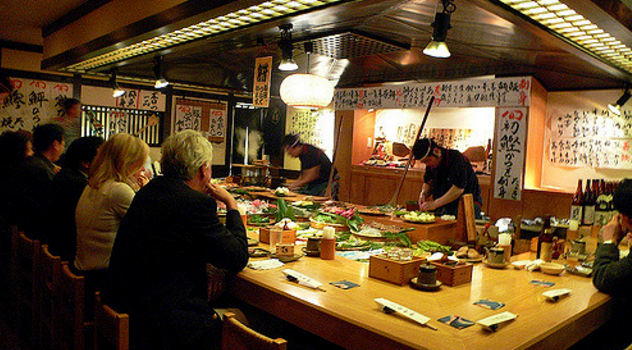Food
An alphabet soup guide to confusing restaurant menu terms

(Photo: Cory Doctorow/Flickr)
NEW YORK – Okonomiyaki, anyone?
A survey released Tuesday for the restaurant reservation site OpenTable showed that style of savory Japanese pancake is the No. 1 most befuddling term among 2,035 diners, with one in five saying they won’t order something they don’t understand on a menu.
Foodies, stand down. Many of the Top 10 most confusing terms you’re likely familiar with. For the rest of us, as chefs in America have expanded their horizons, we bring you gochujang, piri piri, yuzu and bibimbap, following okonomiyaki in that order.
Nearly one in three diners in the Harris Poll conducted online for OpenTable said some menus are more confusing than they need to be. More than half surveyed in March felt ordering an unfamiliar item ruins their restaurant experience.
Okonomiyaki was a challenge for 69 per cent of the diners ages 18 and over, about half of whom said they eat out at least once a month. But there’s rarely shame. The survey of diners around the country showed two-thirds aren’t embarrassed by their cluelessness, saying they are usually fine asking a server for guidance, said Caroline Potter, OpenTable’s chief dining officer.
The fact that some of the rubs, ingredients and completed dishes are a problem at all shows just how far many mainstream restaurants have come, she said. For instance, the 2014 edition of “The Foodspotting Field Guide,” featuring 75 dishes chosen by a gaggle of recreational foodies, posed this question: “Ever heard of Okonomiyaki?”
Now, at least among those who don’t know classic Japanese cuisine, “It’s much more prevalent on American menus,” Potter said. “It’s interesting that there still remains this confusion on the diner side, whereas chefs and restaurateurs have latched onto it.”
The menu issue doesn’t mean some components aren’t easily identifiable.
“While you may recognize, you know, carrots, you might not recognize when it says on a menu they’re rubbed with harissa,” Potter said, noting that particular North African spice mixture of chili, cumin, garlic, coriander and olive oil occupies the No. 11 spot on the list of confusing menu terms.
In addition to roaming the globe looking for inspiration or to expand their repertoires, the farm-to-table movement has chefs reconsidering heritage techniques that might not be widely known by name.
Ballotine, for example, is a piece of roasted, braised or poached meat, poultry or fish that has been boned, stuffed, rolled and either tied or stitched. Think turducken. It’s a classic French way of cooking a chicken thigh, intended to be reshaped to look like one, but the word was unknown to 61 per cent of diners surveyed, capturing the 10th spot on the list.
It’s clear, Potter said, that diners are trying to catch up with the ambitions of chefs.
“Chefs are reaching back, they’re reaching to all corners of the globe. When you talk to chefs, the way they’re spending their downtime, they’re saying I’m going to Thailand for two weeks and I’m going to eat my way through street food and all these restaurants and come back with inspiration,” Potter said.
Potter thinks yuzu, which 64 per cent of those surveyed found confusing on menus, is a good example of an ingredient enjoying big love from chefs in the U.S.
Dallas restaurant Victor Tangos, for example, has used the aromatic Asian citrus fruit known mostly as a flavouring in everything from tempura-fried Brussels sprouts to an infusion for a cocktail made of gin, shiso (No. 8), French wild cherry liqueur, lemon, honey and orange flower water.
“Restaurants are doing everything from serving yuzu miso brown butter on their lobster to yuzu marmalade or yuzu vinaigrette,” Potter said.
Recently, at a Manhattan restaurant, she ran across a yuzu pound cake and a yuzu jelly.
“That, in particular, is really sweeping the nation, and I have to admit I was kind of, like, what is yuzu exactly?” she said.
There is, of course, a segment of diners in search of familiarity and comfort in restaurant food, Potter said.
“We do know that diners want to see more descriptors on menus, and they also like to see pictures. That plays to our food photo culture. Instagram is filled with food pictures. That desire is a by-product of how visual our food culture has become,” Potter said.
So what is gochujang, the second most confusing term? It’s a savory, spicy, pungent fermented Korean condiment made from red chili, glutinous rice, fermented soybeans and salt. It was deemed confusing by 67 per cent of diners surveyed.
And No. 3 piri piri, which was misunderstood by 64 per cent? It’s a Portuguese term for hot chilies or a hot sauce made from them. No. 5 bibimbap is a Korean dish of rice topped with sauteed vegetables served with chili paste, beef or other meat, sometimes with a raw or fried egg.
Gougere, a puff pastry flavoured with cheese (usually Gruyere) and often stuffed with a savory filling, showed up at No. 6, followed by guanciale (a type of Italian cured pork made from the cheeks of a pig); shiso, which is an Asian plant in the mint family used as an herb in cooking; and en brodo, a beef or vegetable stock often used on its own as a broth or as the base for sauces and stews.
___
OpenTable menu jargon decoder:
http://www.opentable.com/m/misunderstood-restaurant-menu-terms-decode





















